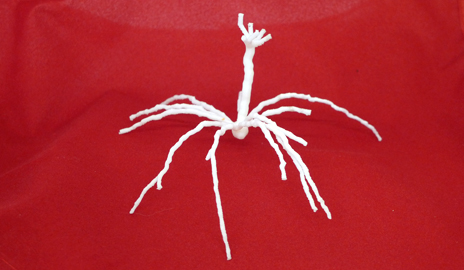First 3D-printed model of a neuron
November 15, 2013
[+]
Yale neuroscientist Gordon Shepherd has created the first 3D-printed neuron with help from the Yale Center for Engineering Innovation and Design (CEID).
3D-printed model of a neuron (credit: Yale University)
“Brain microcircuits have a very complicated 3D architecture,” said Shepherd, a professor of neurobiology at the Yale School of Medicine and author of The Synaptic Organization of the Brain, a classic in the literature of neurobiology.
“The model will give us unprecedented appreciation of this architecture. It’s like being with someone versus having just a picture.”
“The wild, seemingly haphazard geometry of a neuron, with its cell body, delicate branches of dendrites, and long fibers make it nearly impossible to fabricate by conventional means,” said Joseph Zinter, the CEID’s assistant director. “But 3D printers can easily handle these types of complex geometries. They’re the ideal technology for this kind of project.”
Shepherd’s lab team prepared 3D digital images of a specific mouse neuron. Zinter and designer Yusuf Chauhan then converted the data into a language readable by the CEID’s printers and set them to work.
Within a day Shepherd beheld a hugely magnified but otherwise precise replica of a murine mitral cell, or mouse olfactory neuron. Made of plastic, it measures 4.25 inches high by five inches wide, thousands of times larger than the real thing.
“We’ve been inspecting it from every angle and comparing it with experimental data, ” said Shepherd, who has already presented it to groups of other scientists. “There was a bit of a stunned silence when I pulled the model from its box and held it up for all to see,” Shepherd said of a presentation at Yale. “There definitely seems to be something unexpected about seeing a nerve cell in this new guise for the first time.”
“In addition to being used for the fabrication of models, prototypes, and usable parts, 3D printing allows for the visualization of information in new and exciting ways,” said Zinter. “The ability to interact with information in an additional dimension, whether it’s a microscopic neuron or a patient’s CT scan, will lead to new insights and discoveries. Researchers are still on the cusp of how to best use 3D printing technology.”
Shepherd already has plans for 3D prints of more intricate neural networks. “We see a future in which 3D models of nerve cells will be an integral part of doing research and of teaching neurobiology,” he said.
(¯`*• Global Source and/or more resources at http://goo.gl/zvSV7 │ www.Future-Observatory.blogspot.com and on LinkeIn Group's "Becoming Aware of the Futures" at http://goo.gl/8qKBbK │ @SciCzar │ Point of Contact: www.linkedin.com/in/AndresAgostini
 Washington
Washington